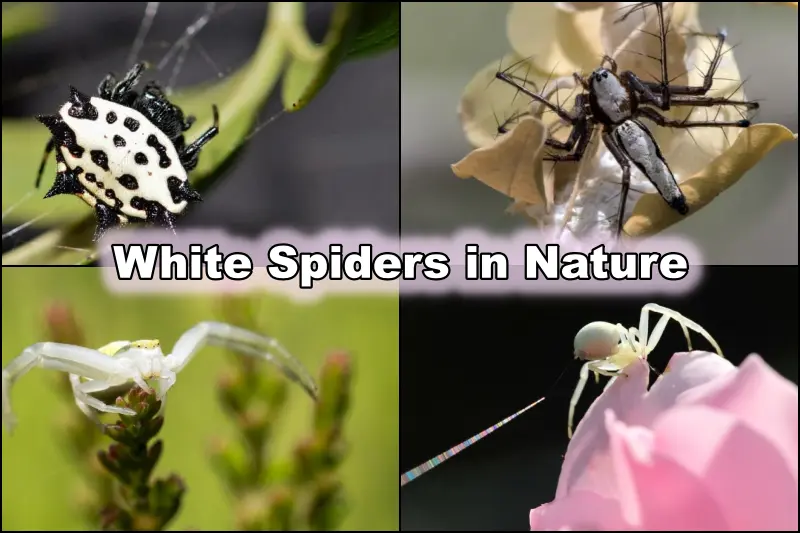Wonderful White Spiders in Nature!
The wonders of nature never cease to astonish us. One such wonder is the existence of white spiders in nature.
We are sure you’ll be delighted to learn some fascinating facts about those tiny crawlies that constantly appear in your yard. So, without a delay, let’s explore 25 stunning white spider species in nature in this article.
I. White Crab Spiders
1. Australian crab spider
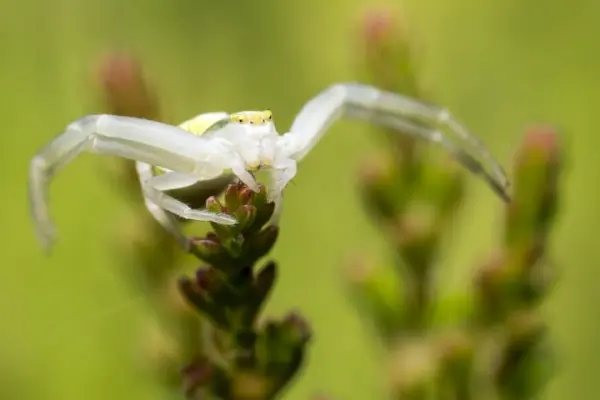
| Scientific name | Thomisus spectabilis |
| Location | Suburban or urban locality of Eastern Australia |
| Size | Body length: female-10mm, male-6.2mm, & including legs- 10cm |
| Identification | Occasionally yellow, mostly white with head & legs almost translucent |
Thomisus spectabilis, also known as the Australian crab spider, is a small spider found in Australia and far east Asia.
Though it occasionally appears yellow, this spider is typically white. The head and legs seem to be almost translucent. The ambush predator Thomisus spectabilis is frequently spotted resting in flowers of the same coloration.
Due to their attraction for symmetry, these mainly insect-consuming spiders also catch pollinating insects like butterflies and bees.
Additionally, to attract bees, the spider uses the UV light reflection of its color pattern to generate a color contrast in their area of vision. These spiders do not weave webs but rather chase and ambush their prey.
Thomisus spectabilis is a venomous species. They tend to be more aggressive than most spider species and have higher bite rates. Their bites are not lethal but might lead to mild symptoms like localized pain.
2. Misumena vatia (Goldenrod Crab Spider)
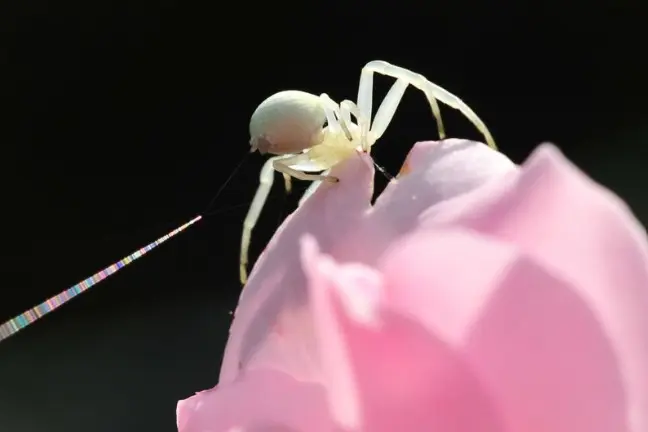
| Scientific name | Misumena vatia |
| Location | North America and Europe |
| Size | Females: 6-9mm, Males: 3-4mm |
| Identification | Female: The sides are darker, and the outer shell is white to yellow. Red-tinged eye region. The abdomen same color as the carapace, sometimes with no markings, but otherwise with a red band on both sides. Legs are a light color
Male: Carapace is reddish-brown, with a white mark running to the eyes and clypeus in the center. Legs’ first two pairs are reddish brown, while the following pairs are yellow. Dorsal and lateral red bands are present on the abdomen, which has a white background. |
Misumena vatia, a stunning species of crab spider, is also known as the “goldenrod crab spider” or “flower spider” because it frequently hunts in milkweed and goldenrod plants.
You might say that their abdomens resemble marshmallows or off-white sponges in appearance.
Their bodies are typically wide, flat, short, and crab-like. It can walk both forward and backward, as well as sideways. It uses the first two pairs of its eight legs, which are the longest, to trap prey.
Misumena vatia‘s venom is too mild to pose a threat to larger animals. Also, its fangs cannot pierce human skin, making it harmless to people.
3. Misumessus oblongus
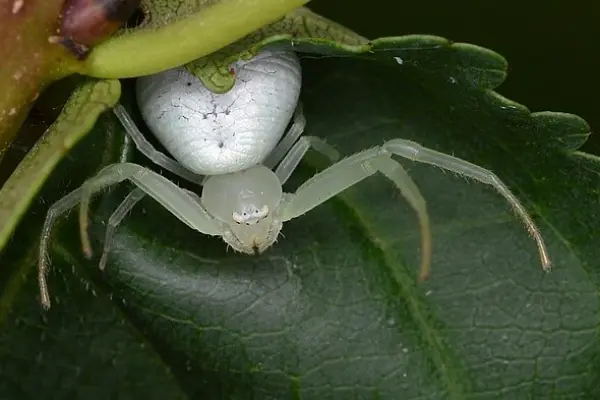
| Scientific name | Misumessus oblongus |
| Location | Canada & the U.S. |
| Size | Female: 4.45-6.01mm, Male: 2.56-2.96mm |
| Identification | Pale greenish to white carapace with a few spines, especially in females |
Misumessus, the Crab spiders belong to North America and the Caribbean in origin. Although considerably spinier, they resemble Misumena in appearance. It is a member of the Thomisidae family. Usually, you may encounter them in Canada and the US.
For this species too, the body length of females is larger than males. They have a carapace pale greenish to white with few spines, especially in females. Males often have a red stripe along the margin. And these characteristics account for their identification features.
4. Leucorchestris arenicola (Dancing White Lady Spider)
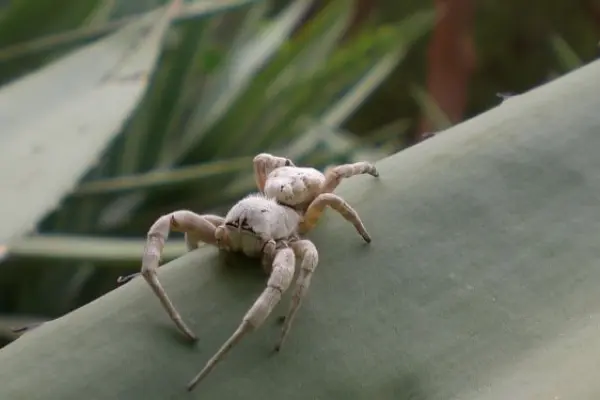
| Scientific name | Leucorchestris arenicola |
| Location | Namib desert of Namibia |
| Size | Up to 32mm |
| Identification | Creamy white in appearance. Males are lighter in weight and have greater leg spans than females. |
Leucorchestris arenicola is a huntsman spider in the family Sparassidae, which is creamy white in appearance. It is found in the Namib desert of Namibia.
They feed on many year-round food sources, including insects, arachnids, and reptiles. Within these groups, L. arenicola nocturnally preys on over 97 different species.
Their prey mostly includes beetles, moths, and weevils, which are nocturnal organisms as well.
One of the key characteristics of its nocturnal habit is its highly developed vision, which uses eight eyes with different orientations to capture an expansive picture of its surroundings.
This spider species communicates by drumming, which is seismic vibrations by tapping its front legs on the sand.
A male L. arenicola will move more than 50 meters in one night in search of a mate. If they do find one, they tend to act cautiously to avoid sending the wrong message.
II. White Jumping Spiders
5. Thiodina hespera
| Scientific name | Thiodina hespera |
| Location | Western U.S. |
| Size | Male: 5.6 mm, female: 7 mm |
| Identification | Bulbous setae on the ventral surface of the tibia |
Jumping spiders have particularly vivid colors. They appear to be full of personality because of how they act and appear fearless, extremely visual, and alert.
They are vicious predators that behave like giant cats, stalking prey, leaping or running at it, then biting and pinning it (occasionally they target insects much larger than themselves).
Females of the species Thiodina hespera are quite large, measuring between 10 and 12 mm.
They are a kind of diurnal hunter. Furthermore, they indicate a peak in abundance around May, however, this might simply be the result of more focused collecting efforts rather than genuine population peaks. They are frequently found in homes and citrus trees.
6. Pelegrina aeneola (Coppered White-cheeked Jumping Spider)
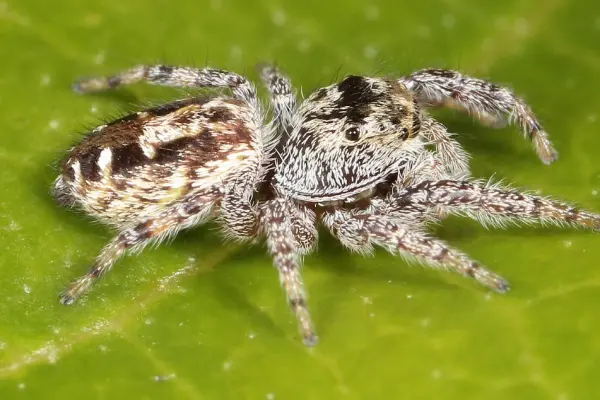
| Scientific name | Pelegrina aeneola |
| Location | Western North America |
| Size | Male 5 mm; female 5.5 mm |
| Identification | Coloring serves as the main identification |
Pelegrina aeneola, often known as the “Coppered White-cheeked Jumping Spider,” is a species of the Salticidae family. There is only a little information available on this species.
Pelegrina aeneola mostly inhabits a variety of vegetation types in western North America, including Canada and Mexico.
Females are primarily white, with some brown markings on their legs, black on their forehead, and brow n on the top of their belly. However, the males of this species might not be on our list of white spiders in nature.
Males, on the other hand, can be distinguished from females by their black legs and pedipalps. They have dark brown carapace, lighter brown belly, and white markings on their pedipalps and legs.
7. Hentzia mitrata (White-Jawed Jumping Spider)
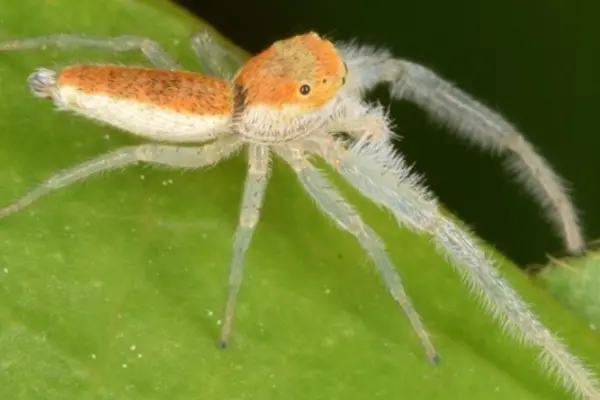
| Scientific name | Hentzia mitrata |
| Location | Bahamas, Canada, and the United States. |
| Size | Between 3-5mm |
| Identification | Long front legs and lengthy white fringes & a circle of red hairs on the head that resembles a crown |
The jumping spider species Hentzia mitrata is commonly called the white-jawed jumping spider. It belongs to the family Salticidae. And they can be spotted throughout the Bahamas, Canada, and the United States.
May is the month when they are most frequently seen outside.
Although Hentzia mitrata is only about 3 to 5 mm, the males can appear considerably big due to their impressively long front legs and lengthy white fringes.
Because the circle of red hairs on the species’ head resembles a crown, it is sometimes known as the “crowned hentzia jumping spider“.
They widely inhabit in and around wooded areas, while they have a high preference for tree canopies.
8. Yellow Sac Spiders
| Scientific name | Cheiracanthium mildei |
| Location | Europe, North Africa, the Caucasus, and Central Asia |
| Size | 7 to 10 mm for an adult |
| Identification | A pale green or tan body, with darker brown palpi and chelicerae. |
The spider species Cheiracanthium mildei belongs to the Cheiracanthiidae family. It partially shares the name “northern yellow sac spider” with numerous other spiders in its genus. Alternatively, the long-legged sac spider is another name for it.
They have been seen around Europe, North Africa, the Caucasus, and Central Asia. Humans are only slightly affected by their venom.
Yellow sac spiders typically inhabit outdoor areas, including gardens, bushes, leaf piles, trees, and woodpiles. They seek prey and interior protection only in food shortages in the colder months.
9. The White Candy-Striped Spider
| Scientific name | Enoplognatha ovata |
| Location | Europe and North America |
| Size | Up to 6mm |
| Identification | Long, thin, translucent pair of legs in the front legs and a globular abdomen that is extremely variable in color and pattern |
This candy-striped spider is a species with an egg-shaped, creamy white body and is a member of the Theridiidae family. Despite being so small, this predator can take down insects that are several times its size.
This species has translucent pale yellow legs and a widely varied color and pattern on its globular abdomen. However, the background is primarily white, cream, or green and can be distinguished by a row of dark dots, a wide red stripe, or two red stripes arranged in a v-shape.
III. White Cobweb Spiders
10. Theridion frondeum
| Scientific name | Theridion frondeum |
| Location | The United States and Bahama Islands |
| Size | Female: 3.0-4.2 mm; Male: 3.0 to 3.5 mm |
| Identification | Along the carapace and abdomen are medium black markings that exhibit considerable variation |
Theridion frondeum is a species that belongs to the Theridiidae family of cobweb spiders. It can be found in the United States and the Bahamas.
Although it has a white background, it frequently has a hint of yellow or green. Medium black patterns that vary widely can be found on its carapace and abdomen.
Compared to its sister species, Theridion frondeum appears much more frequently in environments at high elevations.
11. Theridion albidum
| Scientific name | Theridion albidum |
| Location | Eastern North America |
| Size | Females: 2.5mm; Males: 2.6mm |
| Identification | Translucent and cream-white to pale yellow in appearance |
Theridion albidum is a less common species of the family Theridiidae. Their distribution extends from Eastern North America, from Connecticut to Georgia in the south, Louisiana in the west, and Wisconsin in the north.
This species only inhabits middle and low elevations as its habitat. They have a translucent look and range from cream-white to pale yellow color. However, little research has been done on this species. Additionally, it shares general attributes with its sibling species.
12. Longjawed Orbweavers (Tetragnatha)
| Genus | Tetragnatha |
| Location | All over the world, but mostly in the tropics and subtropics. |
| Size | Females- 5 to 15 mm; Males- 4 to 8 mm |
| Identification | Elongated body & long-jawed |
Long-jawed orb-weavers belonging to the genus Tetragnatha can be found around the world. The majority occur in the tropics and subtropics and can run over water.
They are often called “stretch spiders” because of their elongated bodies and their capacity to stretch their back legs behind them to hide on grass blades or other long surfaces.
Their webs are often huge and spherical, yet as they grow older, they modify them to become circular.
Orb weavers frequently consume anything that gets trapped in their web. This can include insects like grasshoppers, bees, wasps, flies, tiny moths, and butterflies.
13. White Lynx Spider- Oxyopes shweta
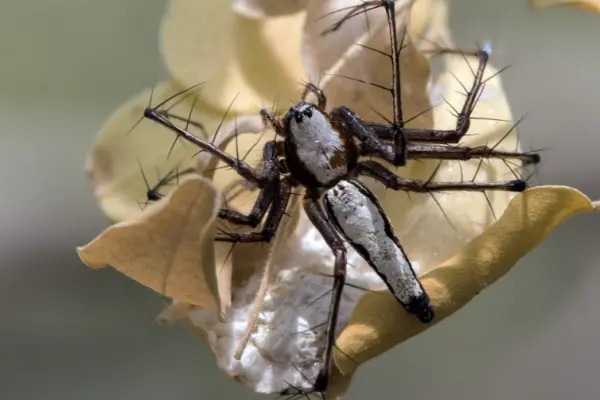
| Scientific name | Oxyopes shweta |
| Location | India and China |
| Size | Female 7-9 mm, Male 5-7 mm |
| Identification | Long chelicerae than their head, conspicuous spines on legs, and a long tapered abdomen |
These fascinating white spiders in nature, commonly known as the White Lynx Spider, belong to the family Oxyopidae.
Oxyopes shweta is a hunter, frequently spotted in the green leaves of plants looking for prey. They often occur outdoors and in January.
It can be identified by its comparatively long chelicerae (fangs) compared to the size of its head, numerous prominent spines on its legs, and a lengthy abdomen that tapers toward the back of the body.
14. Anepsion maritatum
| Scientific name | Anepsion maritatum |
| Location | India, Sri Lanka, China, Malaysia, Indonesia, Brunei, Singapore, Myanmar, etc. |
| Size | About 2 mm |
| Identification | Marble-like patterns on the dorsally convex abdomen |
Anepsion maritatum is a species indigenous to India, China, Sri Lanka, and Sulawesi. The Araneidae spider family includes the Marble Anepsion.
It can be easily identified by the marble-like markings on the dorsally convex abdomen, particularly on the belly of females. Both sexes are around the same size, measuring 2 mm.
Peninsular Malaysia, Indonesia, Brunei, Singapore, Myanmar, Laos, and some regions of China all have significant populations of this species.
15. Arachnura melanura
| Scientific name | Arachnura melanura |
| Location | Widespread in Malaysia, Indonesia, Singapore, Laos, parts of China, India, Japan and Australia |
| Size | Females-17 mm; Males-2mm |
| Identification | The light-brown dorsal median band visibly runs from the two shoulder horns to the posterior end of the abdomen |
Arachnura melanura is sometimes called a black-tail or scorpion-tailed spider.
This orb weaver spider species from the family Araneidae has variations in color from white, pale, yellow, and even brown, which may confuse some people as to whether they belong in our list of white spiders in nature.
It camouflages itself by mimicking twigs, dead leaves, and fallen flowers.
They have a habit of changing the capture spiral on their web. Also, they have interesting-looking bodies that are tan, white, or pale yellow.
It is common in Malaysia, Indonesia, Singapore, Laos, and areas of China, India, Japan, and Australia’s jungle margins.
16. White Spinybacked Orbweaver Spider
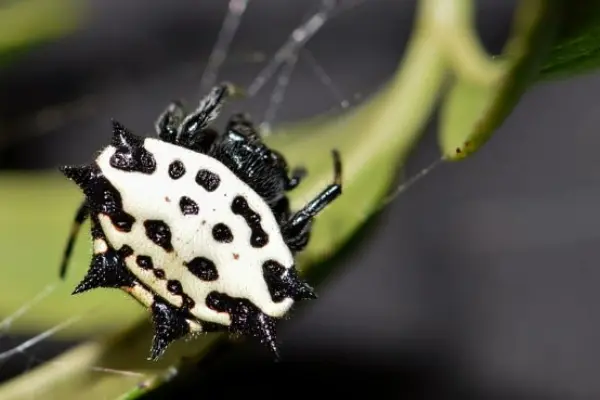
| Scientific name | Gasteracantha cancriformis |
| Location | Native to North America, Central America, the Caribbean, and South America |
| Size | Females: 5–9 mm long, Males: 2-3 mm long |
| Identification | Six abdominal spine-like projections on the abdomen |
Gasteracantha cancriformis is a species of orb-weaver spider from the family Araneidae. These spiders are not too giant or too small in size.
Additionally, there are variations in the color of the upper half of the abdomen, which can be either white or yellow and has black spots in both colors.
17. Argiope aemula (Oval St. Andrew’s Cross Spider)
| Scientific name | Argiope aemula |
| Location | Southeast Asia, India, Sri Lank, Philippines, Indonesia, and Vanuatu |
| Size | Females– 25-30 mm; Males- 5-8 mm |
| Identification | Brownish Cephalothorax with a white pubescence and heart shaped sternum |
The Araneidae spider family includes the species known as the oval St Andrew’s cross spider. This is one of its genus’s huge and noticeable “signature spider” species.
It is often seen in tropical and subtropical grasslands. Their carapaces are covered in silky silver hairs.
Turns out, they like woods in sunny settings with flowers, shrubs, and plants to provide them with protection.
They are typically found close to human populations. Large bidens and enormous fake sensitive plants are frequently present in their habitat. Noticeably, their webs often hang between 1-2m above the ground.
IV. White Cellar Spiders
18. Crossopriza lyoni
| Scientific name | Crossopriza lyoni |
| Location | India, U.S. |
| Size | 2.5 to 7 mm |
| Identification | Distinctly squarish abdomens in sideview and their carapace is less circular when viewed from above. |
A common species of cellar spider known as Crossopriza lyoni prefers to reside inside or close to human settings. They have common names such as box spiders and tailed daddy longlegs spiders.
Surprisingly, they have six eyes and two different types of sound organs.
They are effective mosquito and other arachnid predators. They pose no threat to humans, though.
19. Holocnemus pluchei
| Scientific name | Holocnemus pluchei |
| Location | North Pacific region of the United States, as well as in parts of North Africa, Europe, and the Mediterranean. |
| Size | Males: 5-7mm & females: 5-7.5mm |
| Identification | Long and flimsy legs, sternum brown with brown ventral longitudinal abdominal stripe, black and white rings around leg joints. |
The marbled cellar spider, Holocnemus pluchei, belongs to the Pholcidae family, which is also known as the “daddy long-legs” family. Insects of all kinds, such as fruit flies, house flies, and damselflies, are their primary prey.
Some members of the species live in groups, which permits each spider to spend less energy creating silk for the web even though there is less food for each spider.
It is a typical house spider and makes its nest in basements, eaves, and attics. The majority of species join already-existing webs and frequently migrate, however, some still prefer solitary webs.
V. White Widows
20. Latrodectus pallidus
| Scientific name | Latrodectus pallidus |
| Location | North Africa, Central Asia, and the Middle East |
| Size | Males: 3.5-5.5 mm and females: 11-13 mm |
| Identification | Reddish markings on the central underside |
The white widow spider (Latrodectus pallidus) can give you a painful bite which may feel like a bee or wasp sting. Bites, however, are uncommon and often only occur when a spider is overly bothered.
The white widow spider is rather uncommon to see.
Contrary to most widow spider species, the white widow has darker legs and, as its name suggests, is lighter in color, ranging from beige to white.
VI. Ghost Spiders
21. Anyphaenid Sac spiders
| Family | Anyphaenidae |
| Location | North of Mexico, Ohio |
| Size | 1/4 — 1/2 inch long |
| Identification | Elongated abdomen with pair of long spinnerets, pale in color |
Anyphaenidae is a family of araneomorph spiders. Members of this group are roaming predators that construct silken caverns or sacs, typically on plant terminals and sometimes between leaves, under bark, or under rocks.
Only a few ghost spider species exist in North America to the north of Mexico. People frequently confuse them for the yellow sac spider because they are exceedingly similar to sac spiders (Families Miturgidae and Clubionidae).
22. Wulfila saltabundus
| Scientific name | Wulfila saltabundus |
| Location | U.S. and Canada |
| Size | 3.5-5mm |
| Identification | Tracheal spiracle shifted forward on the abdomen & it is pale in color |
Wulfila saltabundus is another species of ghost white spider in nature that belongs to the family Anyphaenidae.
They are similar in most ways to their siblings in the group. Wulfila saltabundus shares most aspects of its features with other ghost spiders. They too have long, elongated legs that are pale white in appearance, and it is particularly small in size.
This species often shows nocturnal behavior.
23. Hibana incursa
| Scientific name | Hibana incursa |
| Location | Native to North America |
| Size | Male: 5.5 – 6.1 mm, female: 5.7 – 7.0 mm |
| Identification | Pale in color, elongated abdomen, some dark-colored markings all over the body |
A species of ghost spider belonging to the Anyphaenidae family is called Hibana incursa. Native to North America, the species is thriving in all but the northern counties of California.
These spiders are characteristic nocturnal hunters, so they somehow justify their name like that.
All year long, females are gathered for research, while males are only collected from late April to early September.
They most frequently live around fields, houses, and yards with citrus groves.
24. Garden Ghost Spider
| Scientific name | Hibana gracilis |
| Location | Canada and the United States |
| Size | Maybe up to 7mm |
| Identification | These spiders can be identified by their two top eyes and six bottom eyes. |
Hibana gracilis, is another garden ghost spider from the Anyphaenidae family that made it into our list of white spiders in nature.
They belong to a group of spiders whose fangs point in a “cross pattern,” enabling them to pinch down on their victim. Additionally, they have a light, cream tint, earning them the name “ghost.”
Despite the fact that they can have a wide spectrum of harmful effects and are poisonous. However, their prey and predators are often the target of toxins. They are usually harmless to humans.
Moreover, the Garden Ghost white spiders in nature consume other arthropods for food. At night, they eat smaller spiders and insects as food.
25. White Wolf Spider
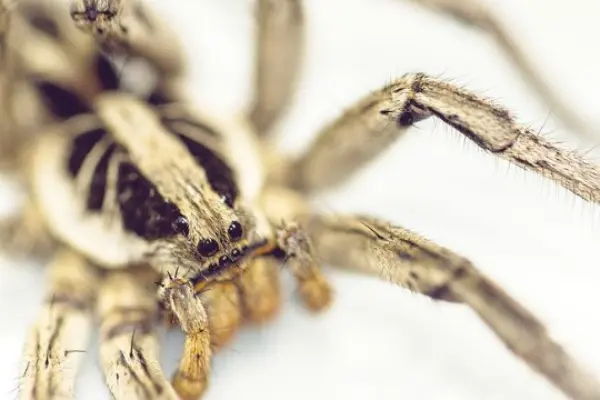
| Scientific name | Ocyale ghost |
| Location | Madagascar |
| Size | Males:16.76–19.45 mm and females:16.47–22.01 mm |
| Identification | Can be identified by the male palp |
The North-Western Boeny region of Madagascar (close to Mahajanga) is home to the huge, visually captivating (Ocyale ghost) wolf spider.
This species now exists only in one small lake in the area, and the population there may only number around thirty mature individuals.
Since its environment is fine white sand, the species is highly habitat-specific and digs shallow burrows there. Given that it is a night-active predator, discovery is almost certain if it is present at other sites.
White Spider Spiritual Meaning
Spiders are amazing animals that are mentioned in many cultures’ mythologies and folklore worldwide. Since white is linked to divinity, witnessing a white spider is typically seen in spiritual terms as a great sign from the universe. So, it’s good to understand their spiritual meaning.
It is a fortunate omen, as the white color implies. Many Native American tribes considered the spider a powerful animal, and some even consider them a spirit guide that assisted departed spirits in transitioning to the afterlife. Therefore, coming across a white spider could be a spiritual communication from the afterlife.
They also represent patience. Spiders possess abundant patience, which is a valuable attribute in life. They construct their webs patiently, wait for prey, and lead orderly lives.
White is a color of purity, fresh starts, and spiritual development. Thus, seeing a white spider may indicate that you are about to set off on a spiritual development path in religious terms.
Conclusion
Our list of the most beautiful white spiders in nature included members of many different spider families. There are undoubtedly many more species than the 25 mentioned ones.
Exceptions in nature, however, are admirable. These white spider species, which ranged from jumping spiders to ghost spiders and some incredibly uncommon ones like the white wolf spider, were worth acknowledging.
FAQs
Q1. Is white spider poisonous?
Ans. Generally speaking, the poisonous nature of a white spider varies depending on its species. Certain species, such as Misumena vatia, also called the crab spider, are the most common White spiders and are poisonous, but their venom poses no risk to humans.
Q2. What is the white spider in India?
Ans. In India, Misumena vatia is the most commonly seen white spider. It is a member of the Thomisidae family. And they are constantly seen around in nurseries, gardens, etc.
Q3. What is the meaning of a white spider?
Ans. No wonder that animals are frequently linked to spirituality as supported by religious beliefs. The same is true for the white spiders in nature. They symbolize purity, perfection, harmony, innocence, dignity, cleanliness, awareness, and fresh starts because they are white.
Q4. Does a white spider bite?
Ans. Even while the majority of spiders are usually docile, some can be aggressive. However, they tend to bite as a kind of self-defense when they sense danger. But most of the time, their bites are not fatal and merely cause minor discomfort, inflammation, and other mild symptoms.
Q5. What happens if you get bitten by a white spider?
Ans. Like other spiders, white spiders can bite. Even while it can hurt, the bite site’s initial burning sensation, swelling, redness, and itching usually go away within a short span and have no lasting effects. Bites from white spiders are not thought to be poisonous to humans.
Q6. What is the superstition about white spiders?
Ans. A spider superstition says you will be lucky if a white spider makes its home above your bed. Since white is a color that is frequently connected to virtues like innocence, purity, and tranquility.
Also Read:

Anjali Prasad, a B. Pharm. graduate who works as a content writer for HowItSee, is based in Delhi. Except for her, not many people take the typical road from healthcare to writing. Her love of writing stemmed from her involvement in the college literature society and her early journaling at the age of 7. Hence, the love of learning and the spirit of exploration are what drew her to this career. You can find her on common social media like Instagram.
